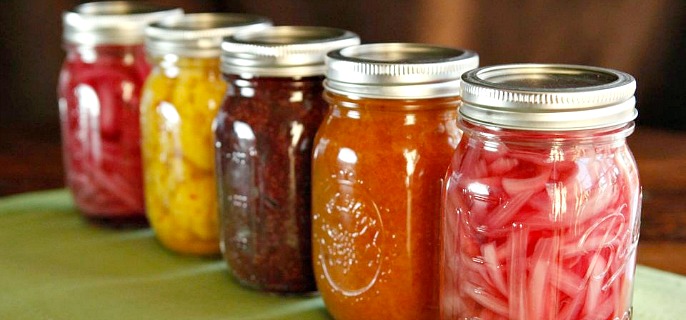
PHOTO COURTESY OF ODA
Families have been home canning for generations and the practice remains popular, especially with more people planting backyard vegetable gardens.
But more home canning also brings people new to the process. The Oregon Department of Agriculture wants to make sure everyone knows the proper steps and precautions when it comes to home canning.
“Home canning can be done all year long but for many folks, this is the best time of year to capture some of those last vegetables from the garden,” says ODA Food Safety Program Manager John Burr. “One thing we don’t want people to do is wing it. It’s important for home canners to follow all the right directions in order to preserve foods safely.”
As many as 1 in 5 American households do at least some home canning. The key factor in safe home canning is the acid level of the food. The lower the acid level, the more likely a problem might occur. Low-acid foods generally include red meats, seafood, poultry, milk, and all fresh vegetables except for most tomatoes. Foods that contain enough acid to block the growth of bacteria include fruits, pickles, sauerkraut, jams, jellies, marmalades, and fruit butters. Much of the time the food of choice in home canning is a fresh vegetable. That can be a potential problem if the canning is not done safely as bacterial contamination can happen all too easily.
“Obviously, the biggest concern is botulism, which can be deadly if products are not cooked to the right temperature, time, and pressure,” says Burr.
Clostridium botulinum is the bacteria responsible for producing the toxin in improperly prepared sealed jars of food. Ingesting the toxin can lead to paralysis or even death. The only sure way of protecting low acid home canned foods is to prepare the food by using a pressure cooker that can reach the appropriate temperature. Boiling water is not a safe method to ward off potential botulism.
“We want people to follow well-written instructions from credible sources on the subject of home canning,” says Burr.
Proper canning techniques depend on up-to-date food preservation information. What might have been acceptable in grandmother’s day is not necessarily good for today. Don’t use outdated publications or cookbooks even if those same guides have been handed down within the family. Excellent sources that are current include The National Center for Home Food Preservation and your local county extension office. Oregon State University Extension Service offers food preservation publications and classes that can help the home canning newcomer.
The safe canning methods available for home canning are all based on pressure canning. Clostridium botulinum can form spores that are very, very heat resistant. Even hours in the boiling water canner will not kill it. Left alive after canning, the germ will grow and produce a deadly toxin inside closed jars of low-acid foods at room temperature, and you can’t always tell by looking. Jars of improperly canned vegetables and meats can contain the deadly botulism toxin without showing signs of spoilage. You can’t taste it or smell it, so you don’t even know it’s there, and it can kill you. The bacteria must be killed during the canning process for safe storage.
The canning process requires selecting a pressure cooker made specifically for canning, and one that is size appropriate for the job. Canners that are too small might lead to undercooking the food. It is important to make sure the gauge on the pressure canner is accurate. There are specific instructions for the type of food, the size of jar, and the method of packing food into the jar. Make sure to follow those instructions.
Initially, the proper home canning of fruits and vegetables calls for using fresh, clean product to begin with. It is advisable to use only high-quality foods which are at the proper maturity and are free of diseases and bruises.
If there is any question that the proper canning process was not followed or completed as instructed, take no chances.
“When in doubt, throw it out,” says Burr, referring to a popular piece of food safety advice used in all situations, not just with home canning.
While a visual inspection of a home-canned product might provide an indication of problems, that’s not always the case. Nonetheless, there are some clues clearly noticeable to the naked eye.
“Check for any conditions of spoilage after you have processed,” says Burr. “Obvious signs might include leaking jars, bulging lids, unnatural colors or odors, and maybe formation of gas bubbles inside the jar. Never eat a food that is suspected to be spoiled.”
Also, never taste home-canned food from suspect cans or jars. If everything looks okay from the outside, it is still advisable to thoroughly inspect the food visually and by smell once the container is opened. Discoloration or bad odor is another sign of potential trouble and the food should be discarded.
The Centers for Disease Control and Prevention report that home-canned vegetables are the most common cause of botulism outbreaks in the US. These outbreaks are attributed to home canners who did not follow canning instructions, did not use pressure canners, ignored signs of food spoilage, or were unaware of the risk of botulism from improperly preserving vegetables.
One alternative to home canning is freezing vegetables. Washing and slicing the vegetable before placing in sealable bags for the freezer enhances the safety of the food and preserves it for a reasonable amount of time.
“But there is no reason to fear home canning,” says Burr. “It just has be done correctly.”
For more information, contact John Burr at (503) 986-4720.
This story is a courtesy of the Oregon Department of Agriculture.









